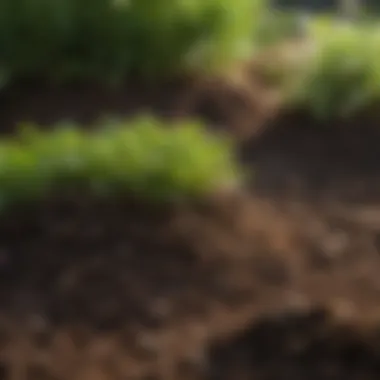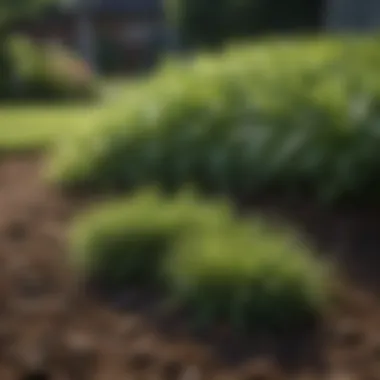Natural Techniques for Effective Lawn Weed Control


Intro
Keeping a lawn in tip-top shape can feel like an uphill battle, especially when those pesky weeds begin to invade. Homeowners often reach for chemical herbicides, thinking it's the only solution, but what if there’s another way? This guide aims to shed light on natural solutions for dealing with lawn weeds.
Understanding why weeds flourish is the first step in tackling them. They thrive due to various reasons: poor soil conditions, overwatering, and, sometimes, the lawn itself not being healthy enough to outcompete them. By employing a range of natural methods, you can not only clear your lawn of weeds but also encourage a thriving, green environment.
Highlighting Key Points
- Cultural Practices: Altering the way you care for your lawn.
- Mechanical Techniques: Methods that involve physical removal of weeds.
- Organic Solutions: Use of natural substances that help control weed growth without harming the environment.
These strategies harmonize with ecological principles and can create an inviting, healthy green space. Whether you’re a stay-at-home parent looking to spruce up your yard or a more experienced gardener wanting to enhance your knowledge, this guide is tailored for all. Let's dig in!
Understanding Lawn Weeds
Understanding lawn weeds is crucial for any homeowner who desires a lush, vibrant yard. Weeds, pesky little devils that they are, can quickly take over and diminish the overall aesthetic of your lawn. Identifying what constitutes a weed versus a cultivated plant is the first step toward effective management. This section will shed light on the significance of understanding weeds in terms of their growth patterns, their impact on grass, and the various strategies available for control without chemicals.
Defining Lawn Weeds
Lawn weeds can be simply described as any unwanted plant that grows in a garden or lawn area. They may not be inherently bad; some can even offer beneficial qualities, but when they outcompete other plants for resources, they become problematic. For instance, dandelions and clover, though often considered annoying weeds, can provide essential nutrients to soil and attract pollinators. However, when they invade a lawn lovingly groomed to showcase uniform grass, they're seen as intruders. To define a lawn weed accurately, one must take its local ecosystem into account, the specific type of grass planted, and the general management goals of the homeowner.
Common Types of Lawn Weeds
In the world of lawn care, familiarity breeds confidence. Here are a few common types of lawn weeds:
- Crabgrass: This annual weed can cause havoc in the summer when it thrives in hot, sunny areas. Its ability to spread rapidly makes it a persistent enemy.
- Clover: This low-growing perennial provides color and attracts bees, yet it can also outcompete desirable grasses, making it a controversial presence on lawns.
- Dandelion: A notoriously resilient perennial, the dandelion’s root system allows it to survive harsh conditions, making it difficult to remove entirely.
- Plantain: Often accompanied by compacted soil, this weed thrives in neglected patches of grass, signaling underlying issues with lawn care.
"Understanding the weeds in your lawn is like knowing the players in a game; it gives you the strategy needed to win."
The Role of Weeds in Ecosystems
While some may argue that weeds only cause trouble, they serve essential roles in their ecosystems. Weeds often act as pioneers in damaged soils, improving its structure and health over time. They can assist in preventing soil erosion and even support complex food webs by attracting various insects. Additionally, their presence may indicate imbalances in the ecosystem, revealing areas that require attention.
In summary, understanding lawn weeds involves recognizing their definition, identifying common types, and appreciating their role within the ecosystem. Grasping these concepts will ultimately empower homeowners to devise effective strategies—without resorting to harsh chemicals—to cultivate a thriving lawn.
Identifying the Causes of Weed Growth
Understanding why weeds are making themselves at home in your lawn is a crucial step toward effective weed management. Each lawn has its nuances, influenced by soil conditions, moisture levels, and even the grass type. By identifying the root causes of weed growth, homeowners can take proactive measures to cultivate a healthy, thriving lawn. Not only does this save time and energy down the line, but it also helps in preserving your lawn’s overall ecosystem.
Overwatering and Poor Drainage
When it comes to lawns, overwatering can be a double-edged sword. While grass needs water to flourish, giving it more than it can handle can create an environment that's a veritable paradise for weeds. Excess moisture leads to poor drainage, which in turn can suffocate the grass roots. This opens the door for opportunistic weeds that thrive in damp conditions, such as chickweed and crabgrass.
Signs of overwatering include:
- Yellowing of grass
- Waterlogged patches
- Rust or fungal growth
To combat this issue, homeowners should adopt a few strategies:
- Monitor the soil moisture - Stick your finger into the ground; if it’s wet, hold off on watering.
- Invest in good drainage - Grass thrives best when water can seep through the soil effectively. If your lawn is prone to pooling, consider regrading or installing drainage systems.
- Use mulch where appropriate - Mulching can help retain moisture while deterring weeds.
Nutrient Imbalance
A well-balanced lawn means more than just good looks—it's a shield against pesky weeds. If your lawn has too many nutrients in some areas and lacks them in others, this imbalance creates a cocktail that’s just right for weed germination and growth. Weeds such as dandelions flourish in nutrient-rich soil where grass is underperforming.
Common indicators of nutrient imbalance include:
- Patchy growth
- Weeds taking over at the edges
- Weeds emerging where fertilization is heavy
To address this concern, regular soil tests become indispensable. A soil test reveals nutrient levels and pH, allowing for precise adjustments. Consider the following actions:
- Use organic fertilizers - They provide consistent nourishment without the risk of excess.
- Rotate fertilizers - This approach ensures no single nutrient dominates, leading to balanced growth.
- Use compost - It’s a natural way to improve soil quality and nutrient content, fostering a healthy lawn ecosystem without chemical additives.
Soil Compaction


Soil compaction is the silent killer of lush, green lawns. Heavy foot traffic, insufficient aeration, or just plain old time can make the ground as hard as concrete. Compacted soil not only hinders the growth of grass roots but also prevents essential nutrients and moisture from reaching them. Weeds can take advantage of these struggling patches, often showing up uninvited.
Signs that soil compaction is an issue:
- Small puddles forming after rain
- Areas of grass that feel spongy
- Difficulty pushing a screwdriver into the ground
To alleviate compacted soil, homeowners can take several measures:
- Aeration - This involves perforating the soil with holes to allow air, water, and nutrients to penetrate deeper.
- Reduce traffic - Rerouting foot traffic in the lawn can help, giving areas a chance to recover.
- Plant deep-rooted plants - Over time, these plants can help break up compacted soil, enhancing aeration.
By being mindful of these causes of weed growth, homeowners can effectively tailor their lawn care practices to achieve a lush and vibrant green space. This understanding lays the foundation for adopting more targeted, natural weed management solutions that not only keep weeds at bay but also promote the health of the entire lawn ecosystem.
Cultural Practices for Weed Control
Cultural practices for weed control are truly vital when it comes to maintaining a healthy lawn. After all, no one wants their patch of green to turn into a jungle of pesky invaders. These practices encompass a variety of techniques that, when implemented correctly, can significantly hinder weed growth while fostering the overall health of your lawn. Essentially, think of it as laying a strong foundation before building a sturdy house.
Mowing Techniques
The way you mow can make a world of difference in weed management. Mowing your grass to a height of around three inches allows the grass to flourish while shading the ground below, making it difficult for weed seeds to sprout. Opting to mow frequently also helps cut off the flowering parts of weeds, preventing them from spreading their seeds. However, over-mowing can weaken the lawn, so be savvy about your schedule. As the old saying goes, "Don’t bite off more than you can chew." For a healthy lawn, keep your mower blades sharp, and don’t mow when the grass is wet, as wet clippings can be a breeding ground for diseases.
Proper Fertilization
Fertilization is another cornerstone in the art of lawn care. Yet, many homeowners make the mistake of using the same formula year after year, oblivious to their soil's actual needs. Each lawn is unique, and assessing soil health is paramount. Conducting a soil test can unveil nutrient deficiencies or excesses, guiding you to apply the right fertilizers at the right times. An application of slow-release fertilizers typically encourages deep-root growth and lush greenery, making it more challenging for weeds to gain a foothold. In addition, avoiding excessive fertilization is key, as too much nitrogen can actually promote weed growth. Remember, too much of a good thing can lead to unfavorable results.
Watering Strategies
Watering your lawn wisely is an often overlooked aspect of weed management. In fact, how and when you water can drastically influence weed competition. Deep, infrequent watering encourages grass roots to grow deeper, making them more resilient against weeds. On the flip side, shallow watering can lead to a weak root system, leaving your lawn vulnerable. Generally, it’s best to water early in the morning when evaporation rates are lower. This also allows moisture to penetrate the soil thoroughly without inviting fungal issues. Also, let’s not forget the importance of monitoring rainfall—overwatering can lead to diseases and promote weeds, negating all your hard work.
"An ounce of prevention is worth a pound of cure."
Mechanical Methods of Weed Removal
When it comes to keeping a lawn free from pesky weeds, mechanical methods of weed removal stand as a cornerstone in the repertoire of natural solutions. Utilizing physical tools and techniques not only reduces the reliance on chemical treatments but also fosters a healthier lawn environment. It’s like taking a spade to the heart of the problem, quite literally digging out the roots of the issue instead of just covering it up.
These methods offer a few key advantages. Firstly, they can be quite effective in controlling weed populations before they have the chance to thrive. Secondly, employing mechanical techniques contributes to soil health, often aiding in aeration and nutrient distribution. It’s sensible to consider these approaches as part of an integrated weed management strategy.
Hand Pulling Weeds
Hand pulling weeds might seem basic, but sometimes the old school ways are the best. This method allows for the removal of weeds without disturbing the surrounding soil much, making it less likely that new weeds will sprout up from disturbed seeds. When pulling weeds by hand, it’s crucial to grasp them at the base and wiggle to loosen the roots before pulling.
However, this task can be back-breaking, especially in a large yard. It’s best to do this when the soil is moist—either after a rainfall or a good watering—because moist soil makes it easier to draw out the entire root system. Also, while you’re out there, consider bringing a bucket or bag to stash the weeds in, as leaving them on the lawn can sometimes result in them rooting again.
Using a Hoe or Cultivator
A hoe or cultivator can be your best friend when it comes to managing weed populations efficiently. These tools aid in both cutting weeds at the soil line and aerating the soil simultaneously. When using a hoe, aim to slice through the weeds just below the surface. This technique is most effective when the weeds are young and tender.
However, it is essential to be gentle and precise with these tools; otherwise, you risk harming nearby plants. A cultivator can also be used to break up weed roots, while simultaneously helping with the aeration of the lawn. This not only makes it harder for weeds to work their way back in but also encourages a healthy grass ecosystem.
Mulching as a Barrier
Mulching serves as an excellent preventative strategy against weed growth. By laying down organic or inorganic materials over the soil surface, you create a barrier that restricts light from reaching weed seeds, thus hindering germination. Organic options like wood chips, straw, or shredded leaves not only suppress weeds effectively but also enrich the soil as they decompose.
Applying mulch should be done mindfully. Aim for a depth of about two to four inches, depending on the material you choose. Remember, while mulching provides a protective cover, it does require periodic refreshing as it breaks down over time. In doing so, you not only keep your lawn looking neat and tidy but also contribute to a robust ecosystem that discourages unwanted growth.
"A proactive approach is the best defense against lawn weeds. By embracing these mechanical methods, you better equip your lawn for healthy growth and resilience."
In summary, mechanical weed removal techniques—whether through hand pulling, utilizing a hoe or cultivator, or incorporating mulch—enhance the overall health of your lawn while combating weeds. Regularly integrating these methods into your lawn care routine will not only maintain the visual appeal of your yard but also promote a thriving grass environment for years to come.
Organic Solutions for Weed Management
In the quest for a beautiful lawn, the battle against weeds can seem never-ending. Organic solutions for weed management play a crucial role in maintaining the health and vibrancy of lawns while minimizing environmental impact. By opting for natural methods, homeowners not only reduce reliance on chemical herbicides but also foster biodiversity and improve soil health. Embracing organics can pave the way for sustainable gardening practices that benefit both the lawn and the ecosystem at large.
Vinegar and Salt


Vinegar, a common pantry item, has garnered attention as a straightforward yet effective weed killer. Its acetic acid content works to desiccate the leaves of many common lawn weeds. When combined with salt, which further dehydrates, this mixture can be particularly potent. To create this solution, mix a cup of salt with a quart of vinegar and a few drops of dish soap to help the solution adhere to the weed foliage.
However, caution is necessary. Salt isn't selective; it will affect not only the weeds but also the surrounding grass if applied indiscriminately. Therefore, ensure you target only the weed patches to prevent damaging desirable plants. Diluting the salt can lessen the risk, especially if you're treating a larger area.
"When using vinegar and salt, it's essential to maintain balance. A little goes a long way."
Boiling Water Application
Perhaps one of the simplest methods, boiling water can be surprisingly effective against weeds. Pouring hot water directly onto weeded areas causes the cellular structure of the plants to collapse, leading to their demise. This method is entirely natural and requires no special ingredients, just diligence.
Apply this method on sunny days for optimal results; the heat from the sun can enhance the boiling water's effectiveness. Bear in mind that while boiling water can tackle many weeds quickly, it can also kill nearby plants if care isn’t taken during application. So, wield the kettle with precision, and stay focused on those pesky invaders.
Corn Gluten Meal as a Pre-emergent
Corn gluten meal acts as a natural pre-emergent herbicide, capable of preventing weed seeds from germinating. This by-product of corn processing contains compounds that inhibit root formation in sprouting seeds. To use it, spread the corn gluten meal evenly across your lawn in the early spring, just before the typical weed germination period.
Using corn gluten meal can provide dual benefits: it helps in weed prevention while adding nitrogen to the soil. The nutrients it releases can support healthy grass growth, making your lawn more competitive against weeds in the first place. As with any natural remedy, consistency is key, so regular application during appropriate seasons will yield the best results.
Creating a Healthy Lawn Environment
A flourishing lawn is much more than just a patch of green. It serves as a sanctuary for leisure, a canvas for outdoor gatherings, and a habitat for various wildlife. However, establishing and maintaining this green paradise requires intentional effort and a strong foundation. Creating a healthy lawn environment involves understanding the interplay of grass types, aeration techniques, and soil health—all crucial factors that can either hinder or promote robust growth while minimizing weed intrusion.
Choosing the Right Grass Type
Selecting the appropriate grass type is fundamental to a successful lawn. Not all grass varieties are created equal; they thrive in different conditions, such as sunlight, moisture levels, and soil types. For instance, cool-season grasses like Kentucky bluegrass perform well in northern regions, whereas warm-season varieties like Bermuda grow best in southern climates. Choosing the right type is akin to setting the stage for a performance; you need the right cast to shine.
Here are a few considerations in selecting your grass type:
- Local climate: Understanding your region's climate is essential. Grass that flourishes in one area may struggle in another.
- Sunlight exposure: Consider how much sunlight your lawn receives daily. Some grass types demand full sun, while others can tolerate shade.
- Usage needs: If children or pets are going to romp around, opt for robust grass varieties that can withstand wear and tear.
Once you've figured this all out, you set the stage for a lawn that is not just visually appealing but also less susceptible to pests and weeds that thrive in stressed environments.
Aeration Techniques
Soil aeration is the process of perforating the soil with holes, allowing air, water, and nutrients to penetrate down to the grass roots. It is a straightforward technique that many overlook, yet it can make a world of difference. A compacted lawn is a weed's best friend; it limits root growth and makes it easier for weeds to elbow their way to the surface.
There are several methods for aeration, including:
- Core aeration: This is the most effective technique. It removes small plugs of soil, allowing the remaining soil to improve drainage and root penetration.
- Spike aeration: This method simply pokes holes into the soil without removing any. While it helps, it’s not as effective as core aeration.
Aerating not only enhances soil health but also improves drainage and reduces thatch buildup—a layer of dead grass and roots that can hinder growth. Regular aeration should be part of your annual lawn care routine.
Maintaining Soil Health
Healthy soil is the lifeblood of a flourishing lawn. Think of it as the foundation of a house; if it’s weak, everything built on top is at risk. To keep your soil in tip-top condition, focus on a few key elements:
- Organic matter: Regularly adding compost or well-rotted manure boosts soil structure. Organic matter improves water retention and provides essential nutrients.
- pH balance: Soil pH can drastically affect nutrient availability. Ideally, you want a pH between 6.0 and 7.0. Testing kits are widely available and simple to use. Adjusting pH might require lime or sulfur applications, depending on whether you're raising or lowering acidity.
- Nutrients: Implement a balanced fertilization regimen tailored to your specific grass type. Too much can lead to nutrient runoff, making your lawn more prone to weed invasion.
"A healthy lawn is like a well-tended garden; it can flourish and defend itself against external threats."
By prioritizing a healthy lawn environment, you're not only enriching your home’s aesthetic appeal but also actively creating a formidable defense against weeds. The integration of these practices will aid in establishing an environment where your chosen grass type can thrive, ultimately leading to a resilient, captivating lawn.
Preventative Measures for Future Weed Control
Weed control is not just about addressing the problem as it arises; it’s about being proactive to ensure it doesn’t become a persistent issue. The significance of preventative measures in lawn care can’t be overstated. By implementing a strategy focused on prevention, homeowners can save not only time and effort but also maintain a healthier lawn environment. Weeds, after all, thrive under specific conditions, and understanding these conditions can help mitigate their growth from the get-go.
Regular Lawn Monitoring
Keeping a close eye on your lawn can make all the difference. Regular monitoring allows you to catch potential weed problems before they take root. This can include checking for early signs of invasive plants and assessing areas where the lawn may be thinning out.
- Tips for effective monitoring:
- Walk through your lawn at least once a week to scout for abnormal growth.
- Look closely at high-traffic areas, as these are often the first places that weaken, making them ripe for weed invasion.
- Pay attention to soil moisture and health; dried-out or overly wet spots can attract unwanted weeds.


By addressing any issues as they arise, you can keep your lawn robust and vibrant. Think of it as a continuous health check; the sooner you spot a problem, the easier it will be to fix.
Seasonal Lawn Care
Seasonal changes can significantly impact weed growth. Implementing a lawn care routine that aligns with the seasons can be a game changer for preventing weeds.
- During spring, focus on aerating your lawn to improve soil health.
- In summer, ensure watering habits support your lawn's needs without saturating it, as this balance is crucial.
- As autumn rolls in, apply mulch in your flower beds to suppress any new weed growth.
- Mulching Options:
- Wood chips
- Straw
- Bark
Routine tasks such as overseeding can also help maintain a dense turf, which acts as a natural barrier against weeds. A thick lawn, much like a solid defense, leaves little room for weeds to settle.
Companion Planting Techniques
An often-overlooked strategy in weed prevention is companion planting. This involves growing certain plants side by side that naturally deter weeds or enhance each other’s growth. For example, mixing flowers with vegetables can not only beautify your garden but also discourage weed proliferation.
- Effective pairings include:
- Marigolds with tomatoes
- Basil with peppers
- Clover in between rows of root vegetables
This approach not only diversifies your garden but creates an ecosystem where weeds find it tougher to gain a foothold. Companion planting can rejuvenate your lawn while providing a barrier that slows down unwanted growth.
By adopting a multifaceted preventative approach, homeowners not only improve the health of their lawns but also foster an environment that supports diverse plant life, minimizing the chances of weed invaders.
Ecological Impact of Natural Weed Control
Understanding the ecological impact of natural weed control is essential for homeowners looking to maintain a healthy lawn while also being environmentally conscious. Choosing natural methods over chemical herbicides not only safeguards your immediate surroundings but also contributes positively to the broader ecosystem. This section zeroes in on the tangible benefits of organic practices, the crucial role biodiversity plays, and how these methods foster long-term soil health.
Benefits of Organic Practices
Opting for organic practices when dealing with lawn weeds often yields a multitude of benefits that ripple through your garden and into the broader environment.
- Improved Soil Quality: Organic methods nurture the soil rather than deplete it, leading to a richer nutrient profile. For instance, by using compost or organic mulches, homeowners create a living ecosystem in their soil that promotes microbial life, crucial for plant health.
- Reduced Chemical Runoff: Chemical herbicides can wash into waterways during rain, harming aquatic ecosystems. On the other hand, using vinegar or boiling water to manage weeds helps avoid this problem, as they break down naturally without the same negative impacts.
"The best weed control is a healthy lawn — and the best way to achieve that is through organic practices."
- Protection of Beneficial Insects: Natural weed management supports populations of beneficial insects, such as pollinators and predatory species, which can help control pests inherently. A diverse insect population is vital in maintaining the balance within your garden.
Impact on Biodiversity
Biodiversity is the backbone of any healthy ecosystem, and the approach to weed control you choose plays a significant role in sustaining it. A lawn that's treated with chemical herbicides may see a decline in diverse plant species, which can be detrimental not just to those plants but also to the insects and animals that rely on them.
- Encouraging Native Species: By managing weeds naturally, you leave room for native plants to thrive. Native species often require less water and maintenance, adapting easily to the local soil and climate.
- Supporting Wildlife: A biodiverse environment attracts a variety of birds and insects, enhancing the ecological web. This symbiotic relationship fosters a resilient ecosystem that can withstand diseases and pests better than a monoculture lawn ever could.
- Disease & Pest Resistance: When various species coexist, the likelihood of diseases and pests proliferating is minimized. This natural resistance makes for a more robust lawn that doesn’t require frequent intervention.
Long-term Soil Health
Soil is the unsung hero of any garden, and how you manage weeds can significantly affect its health over time. A focus on natural weed control leads to better soil health, which is foundational for a thriving lawn.
- Soil Structure and Aeration: Practices like mulching and natural mowing techniques improve soil structure, allowing for better air circulation and root penetration. Well-aerated soil means that plants can access nutrients more efficiently.
- Nutrient Cycling: Organic practices encourage nutrient cycling, where nutrients are replenished naturally over time. This reduces the need for synthetic fertilizers, which can disrupt the soil's natural processes and potentially lead to imbalances.
- Long-lasting Fertility: Techniques that prioritize organic matter, such as cover cropping or using green manures, can lead to sustained fertility in your soil. This means that over years and seasons, your lawn can remain lush and vibrant with less intervention.
In summary, understanding the ecological impact of natural weed control underscores how these approaches do more than just manage weeds. They build healthier ecosystems, promote biodiversity, and improve soil health, bringing benefits that extend well beyond the visible landscape.
Ending
In wrapping up this exploration of natural weed management solutions, it’s crucial to highlight the significance of adopting these techniques not just for the health of your lawn, but for the larger environment as well. The discussion touches on various effective strategies that homeowners can implement to fight against unwanted weeds. By employing cultural practices, mechanical methods, and organic solutions, you not only enhance the appearance of your lawn but also safeguard the ecosystem.
Summarizing Effective Strategies
To recap some of the key strategies discussed:
- Cultural Practices: Mowing at the right height and watering appropriately can significantly deter weed growth. Their aim should always be to promote a strong, healthy lawn that can outcompete weeds.
- Mechanical Methods: Hand pulling is simple and direct, although it requires consistent effort. Tools like hoes and cultivators help manage a larger area more swiftly.
- Organic Solutions: Utilizing kitchen staples like vinegar or corn gluten meal showcases how effective natural herbicides can be. These options are not only safer for the environment but also much kinder to beneficial organisms in your soil.
Encouraging Sustainable Practices
A shift toward sustainable practices not only ensures long-term success in lawn care but also contributes positively to our surroundings. As we adopt methods that minimize environmental impact:
- Think about soil types and microbial ecosystems when selecting your approaches. Understanding the delicate balance can optimize results; this includes being mindful of over-fertilization and other practices that may disturb local ecology.
- Encourage biodiversity by integrating companion planting techniques. This not only helps with soil health but also enhances pollinator populations.
- Regular monitoring is key. Keeping an eye on your lawn’s health allows homeowners to respond promptly to any potential weed issues, preventing them from escalating into larger problems.
By synthesizing these insights, it becomes evident that natural herbicides, cultural management, and mechanical interventions can be harmonized to create a lawn that is both visually appealing and ecologically responsible. Pioneering such practices not only leads to flourishing gardens but also establishes a positive ripple effect on our environment.







